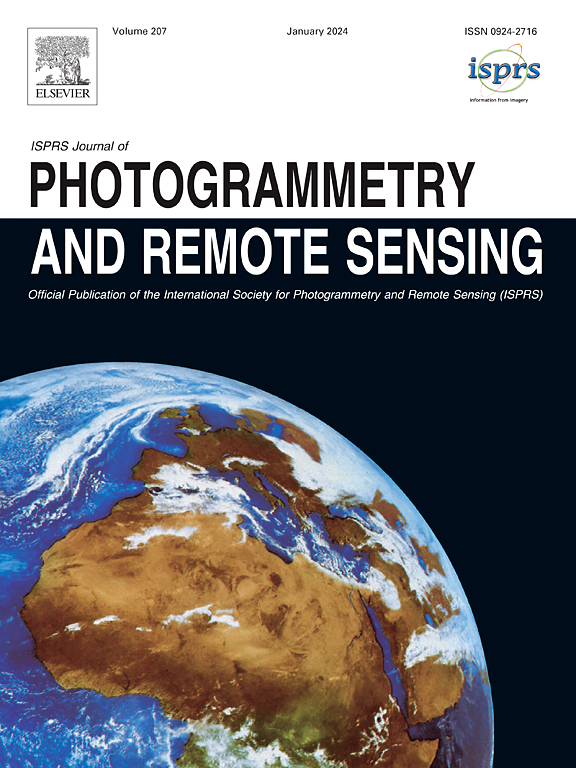利用SAR和光学卫星观测在主动学习的辅助下绘制加拿大地上生物量图
IF 10.6
1区 地球科学
Q1 GEOGRAPHY, PHYSICAL
ISPRS Journal of Photogrammetry and Remote Sensing
Pub Date : 2025-05-24
DOI:10.1016/j.isprsjprs.2025.05.022
引用次数: 0
摘要
在利用卫星观测估算森林地上生物量(AGB)时,国家森林清查(NFI)数据已成为模型训练和验证不可或缺的参考资料。然而,对于像加拿大这样土地面积广阔、森林覆盖广泛的国家来说,获得统计上足够的NFI数据用于模型训练是一项挑战。本研究旨在利用季节性Sentinel 1&;2和l波段合成孔径雷达(SAR)观测的年度马赛克,将所有可用的NFI数据直接升级为高分辨率(30米)空间连续AGB和明确的不确定性地图,覆盖加拿大的树木土地。为了解决有限的训练数据集性能差、无法外推超出训练数据集边界的预测以及无法提供常用随机森林(RF)模型固有的空间显式不确定性的问题,引入了高斯过程回归(GPR)模型和主动学习优化。模型采用分层10倍交叉验证(ST10CV)进行训练,并采用基于欧几里得距离多样性的双向主动学习(EBD-BDAL)进行优化,然后在谷歌Earth Engine (GEE)平台上进行外推。利用EBD-BDAL优化的GPR模型估计,加拿大2020年的林地AGB为40.68±6.8 Pg,其中管理森林和非管理森林分别占82%和18%。森林生态系统外的树木占加拿大林地总AGB的2% (0.8 Pg AGB),城市林地的AGB为0.1134 Pg AGB。不确定性分析表明,GPR模型对高AGB森林具有较好的外推能力,同时保持较低的相对不确定性。ST10CV结果表明,GPR模型无论是否进行了EBD-BDAL优化,其性能都优于射频模型。基于GPR模型和EBD-BDAL优化的NFI升级框架在基于有限NFI数据和季节性卫星观测的国家AGB制图中具有很大的潜力。本文章由计算机程序翻译,如有差异,请以英文原文为准。
Aboveground biomass mapping of Canada with SAR and optical satellite observations aided by active learning
National forest inventory (NFI) data has become an indispensable reference for model training and validation when estimating forest aboveground biomass (AGB) using satellite observations. However, obtaining statistically sufficient NFI data for model training is challenging for countries with vast land areas and extensive forest coverage like Canada. This study aims to directly upscale all available NFI data into high-resolution (30-m) spatially continuous AGB and explicit uncertainties maps across Canada’s treed land, using seasonal Sentinel 1&2 and yearly mosaic of L-band Synthetic Aperture Radar (SAR) observations. To address the poor performance with limited training dataset, failure to extrapolate prediction beyond the bound of the training dataset and cannot provide spatially explicit uncertainties that are inherent to the commonly used Random Forest (RF) model, the Gaussian Process Regression (GPR) model and active learning optimization was introduced. The models were trained using stratified 10-fold cross-validation (ST10CV) and optimized by Euclidean distance-based diversity with bidirectional active learning (EBD-BDAL) before extrapolated on the Google Earth Engine (GEE) platform. The GPR model optimized with EBD-BDAL estimated Canada’s 2020 treed land AGB at 40.68 ± 6.8 Pg, with managed and unmanaged forests accounting for 82 % and 18 %, respectively. Trees outside forest ecosystems account for 2 % (0.8 Pg AGB) of total AGB in Canada’s treed land, and there are 0.1134 Pg AGB within urban treed lands. The uncertainty analysis showed that the GPR model demonstrated superior extrapolation capability for high AGB forests while maintaining lower relative uncertainty. The ST10CV results showed that the GPR model performed better than RF with or without EBD-BDAL optimization. The proposed NFI upscaling framework based on the GPR model and EBD-BDAL optimization shows great potential for national AGB mapping based on limited NFI data and seasonal satellite observations.
求助全文
通过发布文献求助,成功后即可免费获取论文全文。
去求助
来源期刊

ISPRS Journal of Photogrammetry and Remote Sensing
工程技术-成像科学与照相技术
CiteScore
21.00
自引率
6.30%
发文量
273
审稿时长
40 days
期刊介绍:
The ISPRS Journal of Photogrammetry and Remote Sensing (P&RS) serves as the official journal of the International Society for Photogrammetry and Remote Sensing (ISPRS). It acts as a platform for scientists and professionals worldwide who are involved in various disciplines that utilize photogrammetry, remote sensing, spatial information systems, computer vision, and related fields. The journal aims to facilitate communication and dissemination of advancements in these disciplines, while also acting as a comprehensive source of reference and archive.
P&RS endeavors to publish high-quality, peer-reviewed research papers that are preferably original and have not been published before. These papers can cover scientific/research, technological development, or application/practical aspects. Additionally, the journal welcomes papers that are based on presentations from ISPRS meetings, as long as they are considered significant contributions to the aforementioned fields.
In particular, P&RS encourages the submission of papers that are of broad scientific interest, showcase innovative applications (especially in emerging fields), have an interdisciplinary focus, discuss topics that have received limited attention in P&RS or related journals, or explore new directions in scientific or professional realms. It is preferred that theoretical papers include practical applications, while papers focusing on systems and applications should include a theoretical background.
 求助内容:
求助内容: 应助结果提醒方式:
应助结果提醒方式:


